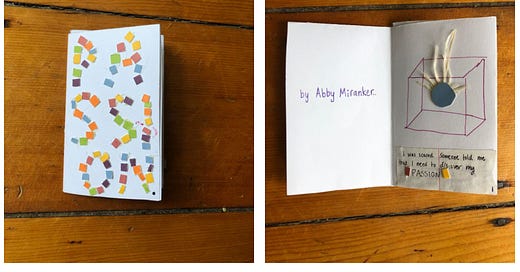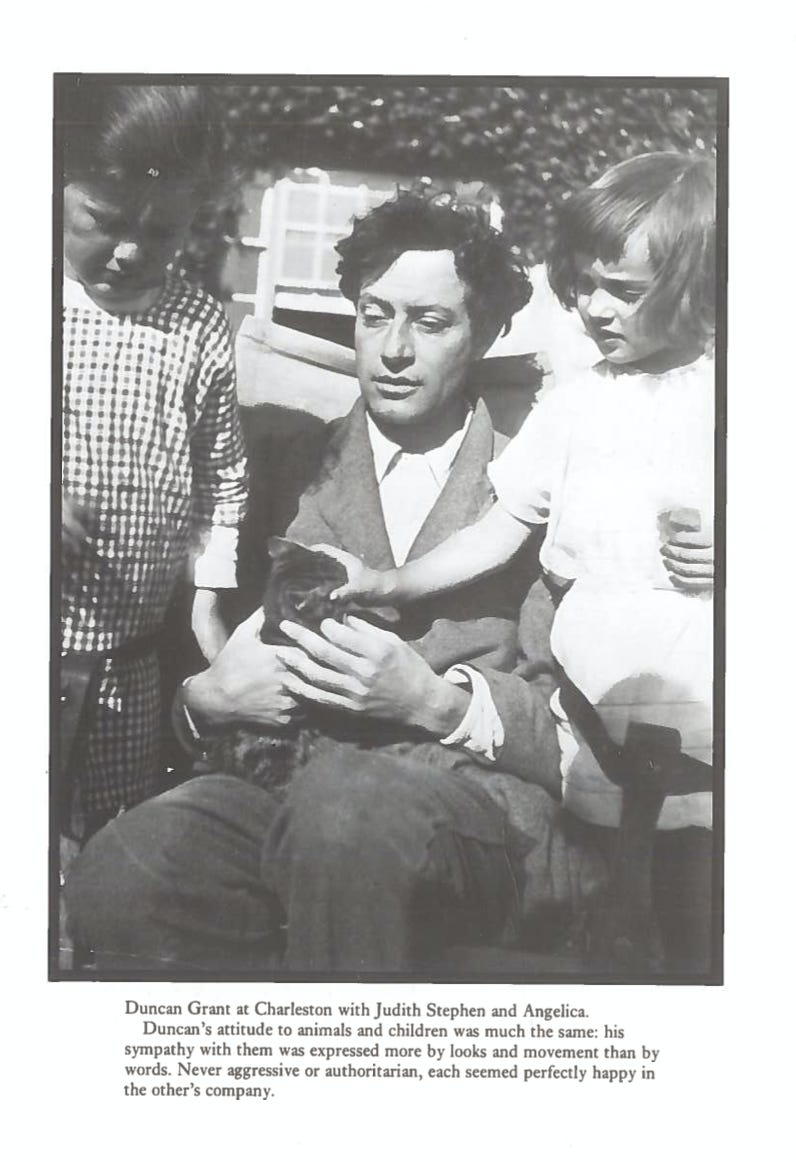Welcome to the sixth Poltern Newsletter!
This week’s issue includes a spotlight on PASSION, a zine that touches on the tumult of selfhood by Abby Miranker, alongside two special features showcasing dissertation topics by the University of Oxford MSt in the History of Art and Visual Culture 2021 cohort: “Nongmingong as Performers: Performances of/by Rural Migrant Workers in China” by Goh Wei Hao, and “Paradoxically Public: Performing private lives in Vanessa Bell’s Family Albums” by Victoria Horrocks.
If you have any questions or comments, please do reach out to us by responding to this email or writing us at polternmag@gmail.com.
Thank you for being here.
The Poltern Team
PASSION | Zine Spotlight
by Abby Miranker
PASSION is a brief, playful zine that tells a story of the unknown and selfhood. Abby seeks a way to document the immense loss and self-doubt that accumulated over the last year due to unforeseen life changes by balancing acceptance and judgment, security and confusion, love and hurt. For Abby, PASSION is about the process of creation and distribution as much as it is about formal content. Conceived in a zine-making workshop during the winter, Abby intentionally left the story and formal style of her work unplanned, resulting in a childlike narrative that brings a sense of comfort and familiarity to readers. As for the medium, Abby believes in the power of replication in all art forms. Photography, text, and publication, are a way to create accessibility in her art. PASSION adapts to its environment and has absolutely nothing to hide.
—
Abby Miranker is an artist and writer currently based in Boston, Massachusetts. To learn more about Abby’s practice or to inquire about PASSION please visit her personal Instagram (@ibuprophet_) or the Take-A-Zine page (@takeazine).
Nongmingong as Performers: Performances of/by Rural Migrant Workers in China | Dissertation Spotlight
by Goh Wei Hao
With dreams of achieving a better life, millions of Chinese workers migrated to cities from rural villages during the reform and opening-up era. These rural migrant workers are referred to as “nongmingong,” a term that describes their socioeconomic status as “peasants” and “workers.” It also delineates their status as outsiders in cities; they are denied access to important social services and chances for social mobility despite their contributions to the cities. Consequently, the nongmingong became increasingly disenfranchised, leading to a growing divide between their urban counterparts and them. This has led to a surge in the number of protests by the workers who turned to corporeal performances to have their demands met. Their plight has also received attention from performance artists, who started to incorporate the bodies of the workers into their works.

Looking at three performances with varying levels of engagement by the rural migrant worker performers — Wang Wei’s Temporary Space (2003), Song Dong’s Potted Landscape (2002), and the performances of protest initiated by the workers themselves — this dissertation examines how the different aspects of the nongmingong are represented through the varying visual strategies adopted in each of the performance. In addition, it looks at how the performances represent the liminal citizenship occupied by the workers in urban and performative spaces, their relationship with the urban population, the individual subjectivities of the workers, the political identity and goals of the nongmingong.

This paper provides unrecognised insights into the ‘everyday’ practices of the nongmingong by shifting the methodological focus away from the artists to examining performances of protests by workers themselves. The study of performances and their visual strategies are also key to our understanding of how the subjectivities of the nongmingong are foregrounded or concealed in a world where socio-political processes are becoming increasingly mediated by visual media.
Watch a video of Wang Wei's Temporary Space (2003) below:
—
Goh Wei Hao is currently a Candidate for the MSt in History of Art and Visual Culture at the University of Oxford.
Paradoxically Public: Performing private lives in Vanessa Bell’s Family Albums | Dissertation Spotlight
by Victoria Horrocks
In the foreword to Vanessa Bell’s Family Album, the 1981 republication of Vanessa Bell’s photo-albums compiled by her two surviving children, Quentin Bell writes, ‘Well then, here without shame or reticence is part of the information that these curious people desire. A photographic record of Bloomsbury at home, Bloomsbury, as the French say, “in its slippers”’. Further analysis, however, reveals layers of narrative and identity construction that belie this intention. Vanessa Bell was a prominent member of the Bloomsbury Group, an assemblage of creatives—namely writers and artists—who gained cultural popularity through their literature and art throughout the early-to-mid twentieth century. The Group’s creative philosophy was grounded in a breaking of Victorian social, political, and artistic convention, prompting its members to lead similarly ‘unconventional’ lives. Producing popular, counter-cultural art and literature in their lifetimes, members of the Bloomsbury Group would have anticipated their individual and collective legacies. Accordingly, Bell captioned each photograph with the names of their subjects and included page numbers in each of her original albums. Retroactive edits were also made to these markings, suggesting Bell prepared them for some public audience. I argue that the albums invoke a slippage between the public and private that uncovers a ubiquity of performance. Bell’s performance of her identity in the albums tactically constructs Bell’s own subjective truth, which complicates the historical conceptions of the Bloomsbury Group through the lens of Bell’s own framing of hers and the Group’s identity.
‘Paradoxically Public’ looks at the family photographs from the artist Vanessa Bell’s photo-albums to revise the boundary between the public and private, and argues instead that these seemingly candid photographs were performative and often staged. Bell assembled nine albums, containing around two thousand photographs of her family—in this case, her children, friends, and lovers—from the years 1896 to 1939. While her paintings were widely circulated in London during her lifetime and received contemporary praise, her photography only met the public eye after she died. As biographers of the Bloomsbury Group began turning to Bell’s family albums to write the histories of its writers and artists, the photographs came to assume an objectivity that critics and Bell’s children relied upon to document the ‘true’ lives of Vanessa Bell and the Bloomsbury Group more generally. Yet, the photographs in these albums take creative license rather than capture, as Quentin suggests, Bloomsbury ‘in its slippers’. Editorial photographs of her children, particularly of her daughter Angelica, suffuse the album, as well as orchestrated scenes between her subjects. The composition of the albums similarly constructs familial narratives by generating discursive dialogue between the images themselves. In other words, the albums, in their arrangement and capacity for narrative, tread the boundary between art and life. Most importantly, they are creative acts—artworks, in their own right.
What identity, then, is revealed when these photographs, supposedly of the ‘private lives’ of the Bloomsbury circle, are made public? And how do the albums construct and present that identity? Rather than revealing the ‘true’ lives of Bloomsbury, I argue that Vanessa Bell’s family photographs instead display Bell’s own performance of her self—one which she hoped would characterise her ostensibly ‘private’ life. Looking at photographs across the original albums, this dissertation demonstrates that layers of subjectivity and a ubiquity of performance have leaked into the images. Through the lens of her Kodak camera, Bell fostered an image of liberation—a freedom of the mind, body, and heart—and an acceptance of her unconventional domestic life. In her images, her rejection of conventional marriage, dynamic interpersonal relationships, hidden parentage of her daughter, and style of collective living were portrayed in such a way that not only normalised them but conveyed them as convincingly idyllic.
My dissertation follows two threads of Bell’s identity, her role as mother and her unconventional family structure. By looking at photographs that address these facets of her character and comparing the narratives of family they draw to alternate accounts of life in the Bloomsbury Group, my dissertation proves first that these photographs reflect Bell’s own self-perception, and then argues that an embrace of this inherent subjectivity need not refute the historical relevance of these images. Instead, I suggest that these albums and their individual photographs, if their subjectivity is embraced, are vulnerable and creative acts on the part of Bell to reveal some personal interiority—a more convincing, and, in fact, more authentic privacy. In Bell’s albums, she reveals a self that, albeit performed, represents an honest self-definition that offers insight into hers and the Bloomsbury Group’s life philosophies. Ultimately, in destabilising the binaries of public and private, false and true, performance and candour, we create space for a more authentic representation of the self.
—
Victoria Horrocks is currently a Candidate for the MSt in History of Art and Visual Culture at the University of Oxford.
Please follow us on Twitter and Instagram (@poltern_) for updates and share our newsletter with anyone who might be interested.






